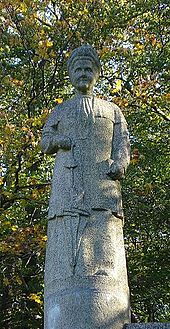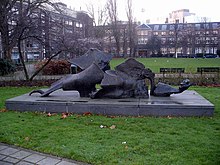Gerrit van der Veen
Gerrit Jan van der Veen (born November 26, 1902 in Amsterdam , † June 10, 1944 in Overveen ) was a Dutch sculptor and resistance fighter against the German occupation of the Netherlands during World War II .
biography
Career as a sculptor
After completing secondary school (HBS), Gerrit Jan van der Veen began training as a mechanic at the railway school and then got a job in the drawing office of the Nederlandse Spoorwegen . His artistic talent showed in his hobbies, the creation of cartoons, for which he invented an apparatus himself, as well as caricatures and wooden figures. He had his first public success when he won a competition for amateur sculptors in Zaandam (around 1924). From 1925 to 1928 he worked for the Bataafse Petroleummaatschappij in Curaçao . By taking decisive action, van der Veen and a few colleagues contained a fire on an English tanker abandoned by the crew, thus preventing the flames from spreading to other oil supplies. Since the men renounced the ship to which they were entitled under maritime law, he received a bonus of 500 guilders from his employer. Van der Veen waived promotion and his employer paid him to return to the Netherlands and granted him an allowance of 60 guilders per month for the first year of study.
After an admission test, van der Veen completed a course of study at the Rijksakademie van beeldende kunsten in Amsterdam with Professor Jan Bronner . In 1930 he was awarded the silver medal of the Prix de Rome . After initial difficulties as a freelance artist, he subsequently received regular commissions, especially for busts and figures such as a monument to Queen Emma in Baarn . Through his contacts in Curaçao, he was commissioned to design a monumental clock for a square in Willemstad . His last work was the De Eendracht Van Het Land sculpture group in front of the Utrecht train station .
In resistance
After the occupation of the Netherlands by the German Wehrmacht , Gerrit van der Veen refused to fill out an Aryan certificate as a member of the air defense . As a result, van der Veen, who was previously characterized by friends as "shy" and "a little boring", developed into a passionate and dominant figure of resistance against the Germans, "a man possessed". Initially, he was involved in artistic circles and was one of the initiators of a petition to the Reich Commissioner for the Netherlands Arthur Seyß-Inquart , which was signed by 1900 artists and in which the occupiers' political influence on cultural life was rejected. When a few weeks later the Nederlandse Kring van Beeldhouwers suggested at a meeting to negotiate a compromise with the Germans, he and friends left the meeting angrily. From 1942 he became editor of the illegal newspaper De Vrije Kunstenaar , in which he wrote a pamphlet against the beginning of the deportations of Jewish people in August 1942 with the title Manifest bij de neitherinvoering der slavernij .
Together with the printer Frans Duwaer , van der Veen founded the Persoonsbewijzencentrale (PBS), in which a team of graphic designers, printers and paper specialists produced around 65,000 forged personal documents and around 75,000 ration cards, which were supplied to Jews, among others. Even the strictest inspectors could not recognize the papers as forgery. 16,000 tobacco coupons were also produced: many of those active in the resistance were heavy smokers because of the great nervous pressure. In addition to this work, he increasingly participated in the armed resistance. On February 10th, he started a fire at the local employment office in Amsterdam, but it did little damage.
On March 27, 1943, Gerrit van der Veen and the writer Willem Arondeus were involved in the attack on the Amsterdam residents' registration office in Apollobuurt . They gained entry in self-made police uniforms and drugged the guards. Then they tore the steel drawers with the index cards from the cupboards, dragged them out, poured gasoline over them and set them on fire. In addition, five time bombs were attached, so that the building finally burned ablaze. The attack was followed by a wave of arrests that ended with the shooting of twelve resisters. Arondeus and the Austrian Karl Gröger were among those executed . On April 29, 1944, the State Printing Office in The Hague was the target of an attack in which 10,000 blank ID cards were stolen. One of the party was Gerhard Badrian , a Jew who had fled Germany and who posed as an SS man . Only 24 hours later, on the night of May 1, 1944, van der Veen's group made repeated attempts to free prisoners from Amsterdam prison, which had previously failed five times. The group was involved in a firefight with the German guards and van der Veen was hit in the back by two bullets. Badrian carried him to his underground hiding place, seriously injured and partially paralyzed. On May 12, 1944, he was found there by the security service and arrested. On June 10, he was together with Duwaer and five other defendants sentenced to death , and in the same day Kennemerduinen in Overveen executed .
Gerrit van der Veen was reburied in the Bloemendaal Cemetery of Honor after the end of the war .
Honors
- In June 1945 the Euterpestraat in Amsterdam, where the German police had their headquarters, was renamed Gerrit van der Veenstraat . A school named after him is also located there.
- On May 7, 1946, van der Veen was posthumously honored with the Verzetskruis (German = resistance cross ).
- In May 1953 with the US Medal of Freedom .
- In 1973 the sculpture Kunstenaarsverzet 1940-1945 by Carel Kneulman was unveiled in Amsterdam.
- In 2002 he received the honorary title Righteous Among the Nations .
Web links
Individual evidence
- ^ Report in the NRC Handelsblad from May 6, 2005
- ↑ a b c d e E.G. Groeneveld: Veen, Gerrit Jan van der (1902–1944). Biographical Woordenboek van Nederland, November 12, 2013, accessed December 17, 2014 (Dutch).
- ^ A b c Barbara Beuys: Living with the enemy: Amsterdam under German occupation 1940-1945. Hanser, 2012, accessed December 17, 2014 .
- ↑ Doc. Printed as document VEJ 12/68 in: Katja Happe u. a. (Ed.): The persecution and murder of European Jews by National Socialist Germany 1933–1945 (collection of sources) Volume 12: Western and Northern Europe, June 1942–1945. Munich 2015, ISBN 978-3-486-71843-0 , S, 257-259.
- ↑ Shirley Haasnoot / Bas Kromhout: Tien grote Nederlandse verzetshelden. Historically Niewsblad, April 2006, accessed December 14, 2014 (Dutch).
- ^ René van Heijningen: Gerhard Joseph Badrian. NIOD, April 2012, accessed December 18, 2014 (Dutch).
- ↑ Jochen Schimmang : Life under the occupiers in Europe's old capital of tolerance . In: Frankfurter Allgemeine Zeitung, January 5, 2013, p. 32.
- ↑ Veen van der Gerrit. Yad Vashem , accessed December 17, 2014 .
| personal data | |
|---|---|
| SURNAME | Veen, Gerrit van der |
| ALTERNATIVE NAMES | Veen, Gerrit Jan van der (full name) |
| BRIEF DESCRIPTION | Dutch sculptor and resistance fighter |
| DATE OF BIRTH | November 26, 1902 |
| PLACE OF BIRTH | Amsterdam |
| DATE OF DEATH | June 10, 1944 |
| Place of death | Overveen |


